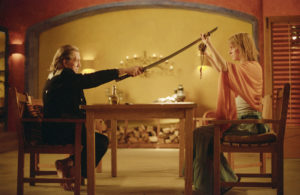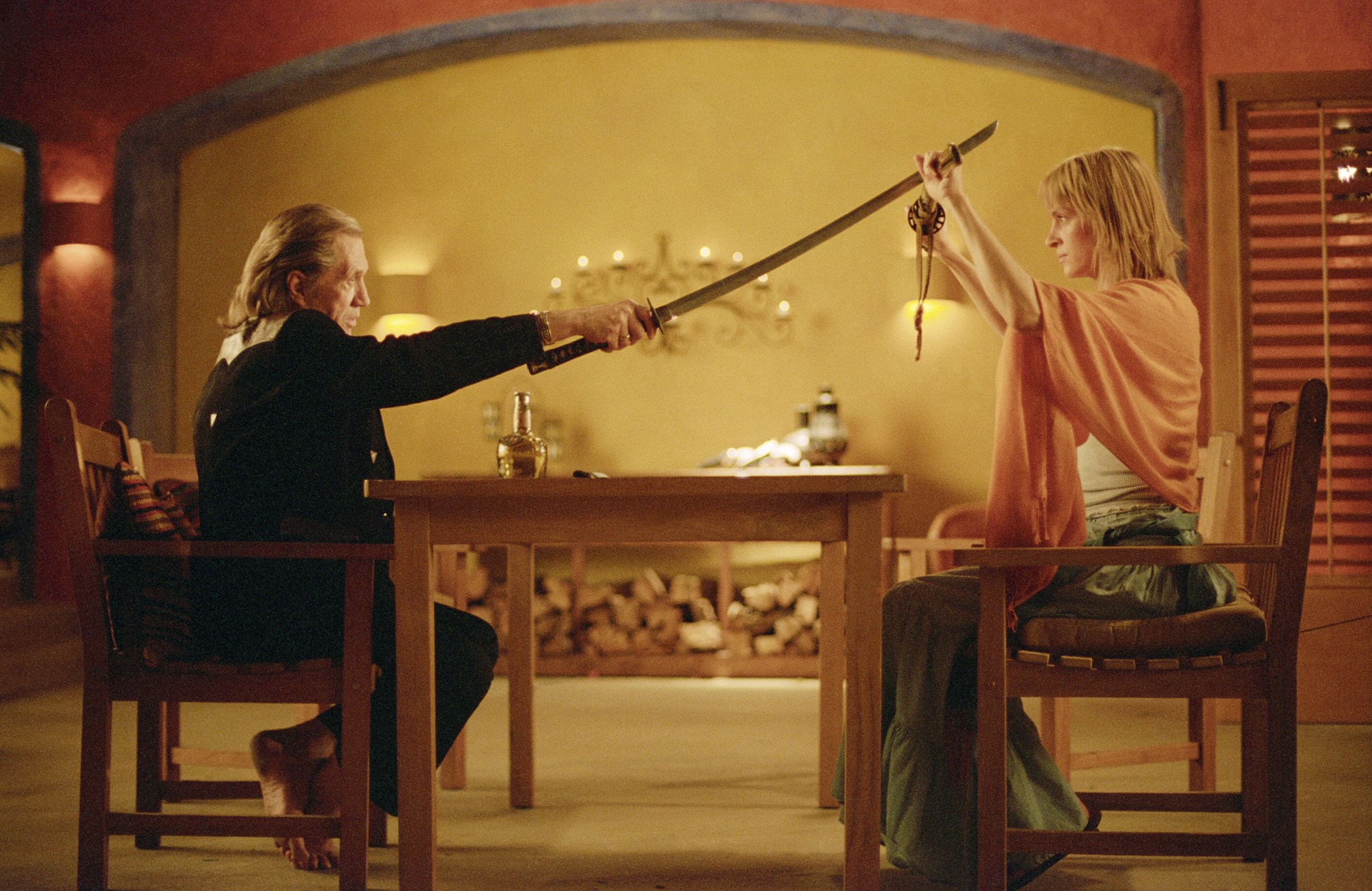Quentin Tarantino’s Kill Bill: Volume 2 is a terrific form of entertainment, a blistering and meditative piece of fiction that gets to the heart of savage warriors. The best sequels enter new territory, ushering in a fresh sense of adventure. Tarantino’s film flips the script and embarks on a journey that transcends what came before. Through the unique melding of western and eastern elements, Tarantino gives us a proper continuation of an already promising revenge saga. The end result is a bruising sequel that stands on its own two feet.

After taking out O-Ren and the Crazy 88 in Japan, the Bride straps on her cowgirl boots and heads for Texas, the home place of Bill’s brother, Budd. Of course, the Bride is destined to battle Budd, Elle, and Bill. That much we know. But make no mistake about it–this is not a story of great predictability. Even with a simplistic story of revenge, Tarantino treats each and every story beat with tremendous care, forming a series of events that keep us glued to the screen.
Volume 1 was a fast piece of fiction, focused on the efficient, Samurai-like exploits of the Bride. In Kill Bill: Volume 2, the environment feels more in tune with western fiction. The running time has been inflated, and as a whole, the action has been slightly minimized, with the intent of exploring the characters that coexist within this movie universe. Like the classics of western cinema, Kill Bill: Volume 2 has a slower pace, adding context to relationships already established in the first volume. The story has more room to breathe, and in turn, the characters begin to resonate even more so.
Tarantino has a history of building strong, independent women. In Jackie Brown, Pam Grier was the smartest character in the entire picture. Death Proof was a film that constructed a likable group of women, expertly balancing individualism and teamwork. In Inglorious Basterds, Melanie Laurent was a master planner, able to hide her most inner demons in plain sight. In Kill Bill: Volume 2, Tarantino’s ultimate female creation cements herself as one of the most iconic heroines in cinematic history.

In some films, women are given one-note roles, devoid of intrigue and layers. If a woman takes on such a role, she enters a cinematic realm of repetition. Thankfully, Kill Bill: Volume 2 is not one of those cases. Uma Thurman is asked to flex a lot of her acting muscles. Her performance is wide-ranging and chronicles multiple points of the Bride’s life. In a brief flashback, we see the Bride’s early days with Bill. When she talks to him, she’s like a giddy kid, completely in awe of the man she’s with. With Pai Mei, she’s a frozen child, filled with insecurities and awkwardness. With Esteban, she’s very adult-like. She speaks in a confidently sensual way, with the intent of charming the man for information.
For decades, men have looked to the screen, admiring male heroes of cinema. When people think of iconic gunslingers, they think of rugged males, like Clint Eastwood and John Wayne. When people think of samurai, they think of specific men, like Toshiro Mifune and Tomisaburo Wakayama. Tarantino, with his unwavering love for cinema, has crafted a female character that is both a gunslinger and a samurai. She belongs to both cinematic schools of thought, and her existence within the annals of cinema gives women a legitimate form of escapism. Hopefully, Thurman’s character will point women toward western and samurai films.
Compared to Kill Bill: Volume 1, this film has a way smaller cast. Consequently, Kill Bill: Volume 2 isn’t as diverse as the first installment, but it commits itself to female power and an effective form of foreign inclusion. Tarantino continues to develop the Bride, and as time progresses, we grow to love her even more. This ever-growing sense of resonance is largely due to Tarantino’s contextual writing, which showcases the Bride’s origin, partnerships, motherhood status, and superhero analogy. At every turn, there is a new way to view the Bride. Thus, we begin to have fresh perspectives that revolutionize this female driven world.

Aside from the Bride, we are introduced to another female warrior, Elle. In a lot of ways, she is the most formidable opponent within Tarantino’s cinematic universe. Every second that she’s onscreen, we feel her forceful personality. She goes through the proceedings, completely confident in her abilities. And as the film progresses, it’s clear that she is the Bride’s equal. At one point in Kill Bill: Volume 2, both assailants utilize the same blow, simultaneously striking out one another in the process. In Tarantino’s mind, the idea of blondes being dumb and afraid their hands dirty is a bunch of bologna.
In a brilliant turn of events, Gordon Liu (a Chinese performer) returns to Tarantino’s canvas, portraying the role of Pai Mei, an eccentric martial arts master. When tasked to play roles of such energy, actors can often feel repetitive or unnatural. In some cases, their antics become much of the same, forming a character that loses appeal very quickly. In other cases, actors run the risk of acting too much, which gives off artificial vibes. Thankfully, Liu handles the role like a true pro. With the guidance of Tarantino, Liu molds the character into a fearful force of nature. Because of Liu’s commitment, the origin story works wonders, providing context for the Bride’s God-like skills.
Tarantino takes these narrative pieces and puts them into a scrumptious looking flick, brimming with photographic accuracy. Together, he and Robert Richardson (the director of photography) summon the contents of visual artistry, giving us precise shots that parallel the existential status of characters. In simple terms, we, the viewers, feel what the characters are feeling. Like Clint Eastwood’s character in The Good, the Bad, and the Ugly (1966), the Bride lies on the floor, beaten and battered beyond beyond all belief. The high-angle shot taps into the Bride’s vulnerability, showcasing her near death status. Then, we have quick zoom ins. These visual devices are used to showcase sudden realizations. For example, when Elle opens the door and sees the Bride approaching, the camera quickly zooms in on her face, paralleling the quickness of newly formed information. Kill Bill: Volume 2 is chock-full of these shots, which are fundamentally designed to inject us with frantic forms of experience.
The utilization of black and white photography in Kill Bill: Volume 2 is a breath of fresh air. From a thematic standpoint, it perfectly fits into the narrative. Traditionally, black and white visuals are synonymous with classical cinema (AKA the past). Ironically enough, the film’s opening is set in the past. We see the Bride’s wedding rehearsal. Bill is properly introduced. We see their partner dynamics. Here, the absence of color creates a world that is truly formal and serious. It sets a somber mood, which definitely lines up with this crucifictional period of the Bride’s life and Bill’s emotional distress. We are not distracted by the vitality of surroundings. We are forced to focus on these subjects, who summon an abundance of life through their performances.

Like Sergio Leone, Tarantino utilizes close-ups in Kill Bill: Volume 2, with the intent of setting up a brewing conflict between warriors. The best action scenes have layers upon layers. Tarantino understands this notion. When the Bride takes on Elle, her greatest enemy, the physical conflict is intriguing on many levels. Obviously, the fight choreography is magnificently done. Thurman and Hannah must be commended for their willingness to execute stunts. However, it’s important to look at Tarantino’s usage of irony, setting, and props.
Finally, after years of waiting, these characters are at each others’ throats, and yet, they are relegated to fighting in a small, dirty trailer. Common logic would tell us that these warriors are destined to fight in an epic environment, but here, Tarantino laughs at our assumptions. As the characters fight, the strangest of objects are used to progress the conflict, whether it be a television antenna, a can of spit, or a nasty commode. This type of cinematic irony imbues the film with subtle humor, grabbing us on multiple viewings.
Even in the midst of such a phenomenal fight, Tarantino throws in clever gags, designed to enhance or levels of entertainment. Hattori Honzo’s sword is a masterful prop. According to legend, his swords are capable of cutting God himself. So clearly, during this fight between warriors, it’s a highly sought after object. Elle is trying to get the sword out of her scabbard. The Bride is trying to keep the sword in the scabbard. When Elle attempts to remove the sword, the claustrophobic environment gets in the way. It’s a conflict within a conflict, and the end result is a core conflict that works on many levels.
This brings us to the “showdown” with Bill. Surprisingly, the final conflict is low-key. It’s not a conflict full of fireworks or flashy choreography. It’s a philosophical discussion, complete with debate, disappointment, and complication. Before this climatic event, Tarantino kept us somewhat distanced from these relational proceedings. Thus, once the Bride and Bill meet for the final time, it’s a fresh, natural conversation between former lovers. The familial atmosphere is expanded upon, providing the flick with an emphasis toward the importance of innocence.

Even with all of her crazy exploits, the Bride is a perfect example of female accountability. She taps into the idea of female survival. No, Kill Bill: Volume 2 is not telling you to slice and dice your opponents. After all, film is entertainment, not educational messaging. If anything, the film is about holding evildoers accountable. It’s about the power that comes with female accountability. It’s about owning your past mistakes and moving toward a better, brighter future.
In conclusion, I highly recommend Kill Bill: Volume 2. In classic Tarantino fashion, specific sections of the film are a tad too long, but overall, it’s a wonderful piece of escapist fiction. All I ask is that you prepare yourself for the slow pace. This installment is firmly focused on the characters and relationships. It sets its sights toward the finish line, knowing full well that the development of characters is the right way to end the saga (for now). 15 years on, fans are still clamoring for a sequel, largely due to the consistency of the first two installments, which created an overarching mythology, complete with heart and brilliant absurdity. I am game for a third part!

Originally published by Dillon McCarty for Incluvie on October 6, 2019.

Comments